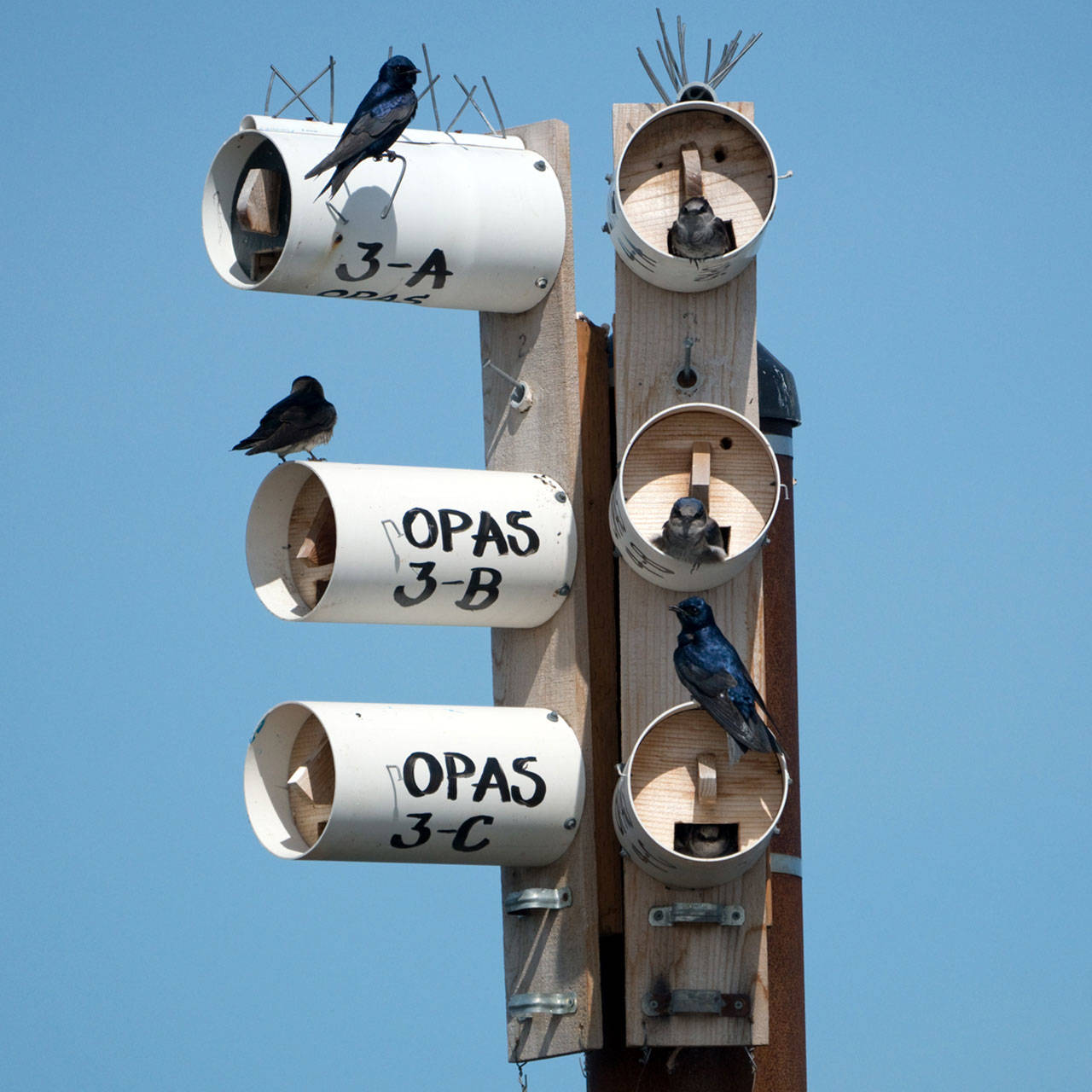PORT ANGELES — A colorful, melodious and regular visitor to the North Olympic Peninsula has new digs on the shoreline.
Members of the Olympic Peninsula Audubon Society, Port of Port Angeles and Port Angeles Yacht Club earlier this year collaborated on a project to install four Purple Martin nest boxes in the Port Angeles Harbor.
Similar to those installed in Dungeness Bay at 3 Crabs, near Morse Creek and at Protection Island’s National Wildlife Refuge, the boxes were built and mounted by Audubon members just east of the Port Angeles Yacht Club inside the breakwater.
Those involved expected it would take a couple of years for Purple Martins to take to the structures, but on June 18, Port Angeles Yacht Club members Kaiyote Snow and Ed Mensing reported at least six of the birds in and around the nest boxes.
Ken Wiersema — who, along with Dow Lambert, led Olympic Peninsula Audubon Society (OPAS) volunteers in the designing, building, maintaining and monitoring the Purple Martin nest boxes — said he was pleased to see the birds already using the PVC nest boxes, designed to provide safe habitat for Purple Martins to reproduce.
“We don’t know if they’re going to be successful (but they’ve) got birds in them right now,” Wiersema said.
That’s a bonus for advocates of the martin, a bird nearly the size of a robin and the largest swallow in North America.
According to Cornell Lab of Ornithology, the dark, glossy-blue males and brown Purple Martin females “peer from the entrances and chirp from the rooftops all summer … (while) in the West, martins mainly still nest the old-fashioned way — in woodpecker holes.”
Purple Martins are also known for their “unmistakable, extremely pleasant chatter,” Wiersema said. “Very charismatic.”
Purple Martins are adaptable birds, finding breeding grounds in a number of climates throughout North America from the Midwest plains and Eastern shorelines to deserts of the Southwest and Pacific shores — pretty much all climates except mountainous ones.
“Once you get east of the Rockies, they seem to have pretty good, stable population,” Wiersema said.
They are long-distance migratory birds, with most East Coast-breeding individuals migrating across the Gulf of Mexico. Those on the West Coast go as far as Argentina.
The martin gets its food and water in flight, snapping up insects and scooping low to skim pond water in mid-flight.
At the turn of the 20th century, the Puget Sound region had healthy numbers of about 20,000 or so, but those numbers dwindled to about 1,000 breeding pairs by the 1950s, Wiersema said.
Their numbers dropped, Wiersema said, because of two major factors: clear-cutting land that eliminated old tree snags in which they’d nest, and the introduction of certain sparrows and European starlings that compete for nesting sites.
In addition, pesticides and herbicides have cut down on the staples of the Purple Martin’s diet: primarily large insects such as mayflies and dragonflies.
“If you don’t have a good insect population … the birds are not able to do very well,” Wiersema said.
The Peninsula’s shorelines are prime territory for the martins, since they offer both freshwater and saltwater insects.
Providing the Purple Martin with nesting boxes can help the West Coast birds maintain their migratory patterns, Wiersema said.
“The long-range objective is to get them back in natural cavities; in the interim …. we have to be able to provide essentially (provide) artificial nest boxes for them,” Wiersema said.
Wiersema — past president of the Olympic Peninsula Audubon Society (OPAS) chapter and current OPAS education chair, as well as the local state Audubon board member for the region — said the state Department of Fish and Wildlife records have documented nesting colonies of Purple Martins in Clallam County from the 1920s.
The birds had small colonies under eaves of the Sol Duc Hot Springs lodge and the Clallam County Courthouse in Port Angeles as late as the 1930s, he wrote.
Since that time, introduction of non-native, cavity-nesting birds have taken many of the natural and human-made cavities found over land sites and forced the Purple Martins to move their nests over water, Wiersema wrote.
In the mid-1990s, OPAS board member Stuart Mac Robbie began a project to build and install nest boxes.
In 2005, at the invitation of the U. S. Fish and Wildlife Service, OPAS expanded the program to include installation of Purple Martin nest boxes on Protection Island, a national wildlife refuge with restrictions on nest box placement to just a few onshore locations.
Over the years, the project volunteers have added other sites — at Dungeness Bay, Diamond Point, an island at the mouth of the Dungeness River, near the mouth of Morse Creek and an area west of Joyce, in addition to the most recent additions on the Port Angeles Harbor.
In August 2018, as many as 70 martins were counted around the 3 Crabs area, and they have been spotted as far west as Neah and Clallam Bay, Wiersema said.
Monitoring the nest boxes usually begins in April and ends in August. The data is sent to U.S. Fish and Wildlife and the state Department of Fish and Wildlife.
For more information, see olympicpeninsulaaudubon.org/purple-martin-nest-box-project.

